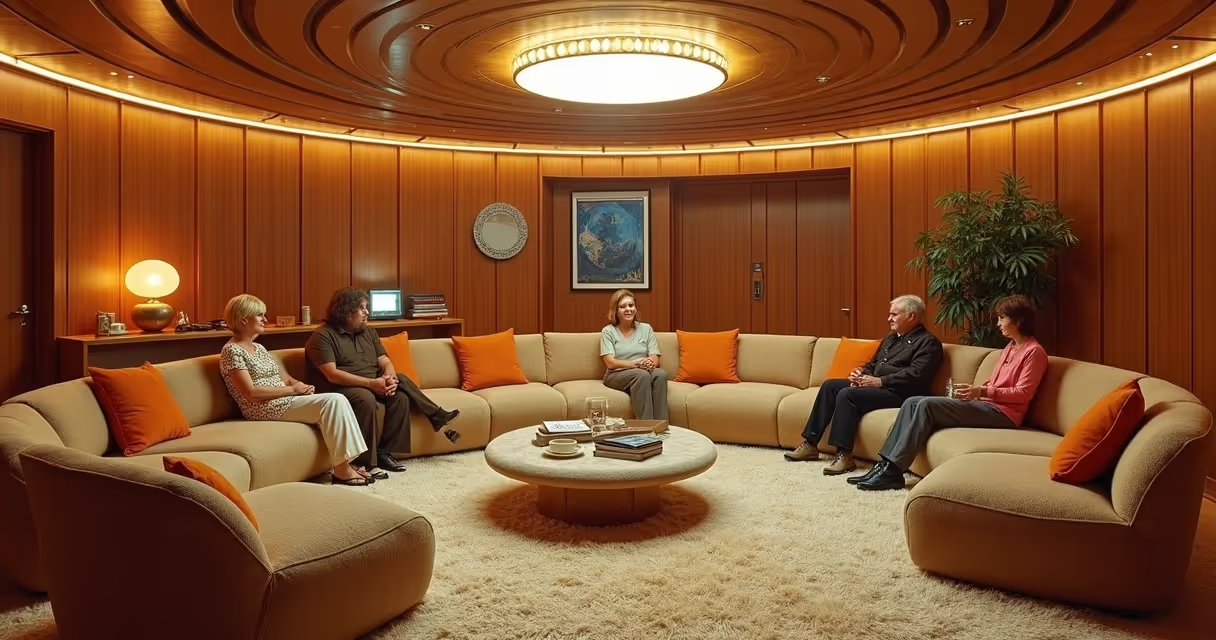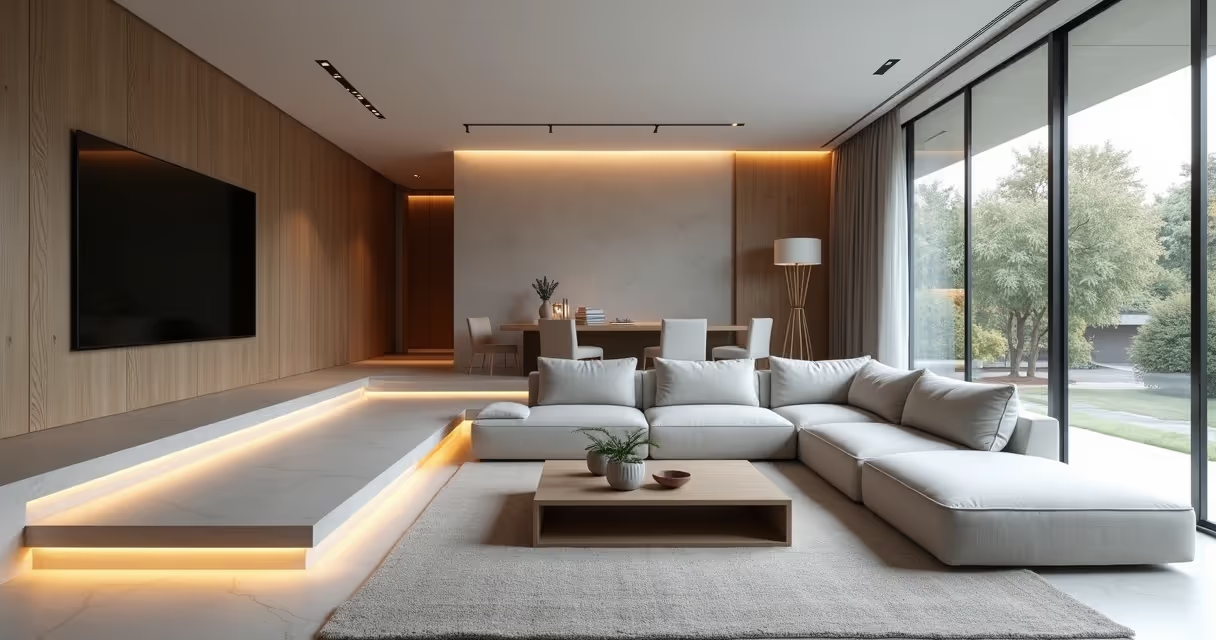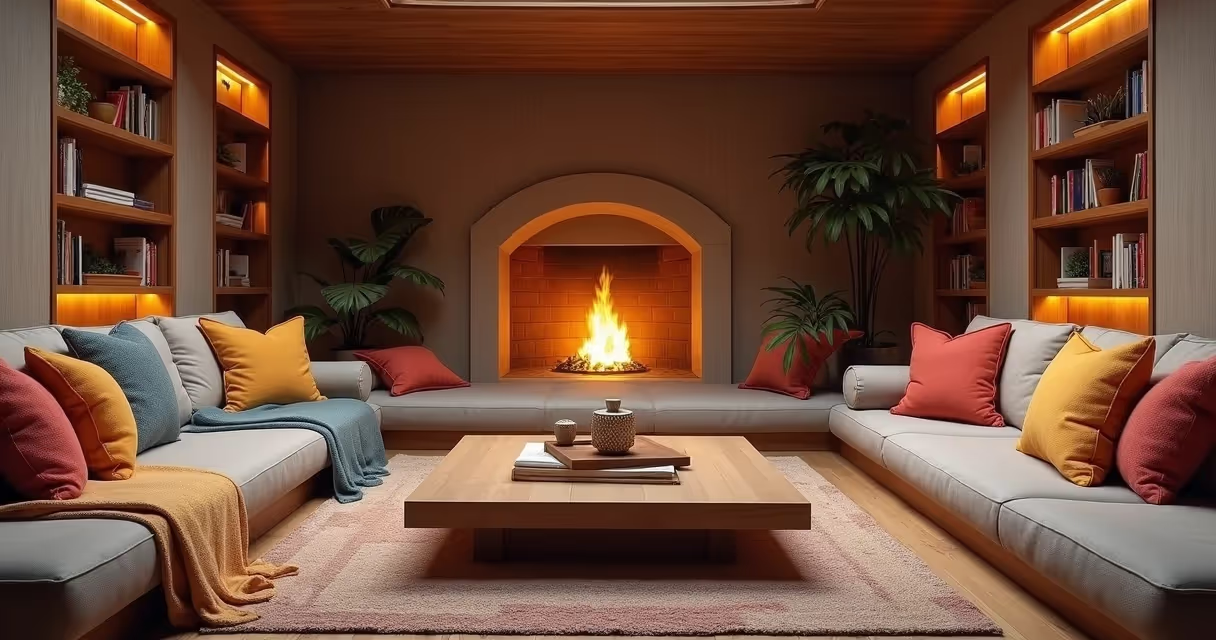Lowered rooms, you may have recently come across photos of modern environments where the floor of the main room is, let's say, “one step below” the rest of the house. No, no one forgot to finish the slab or made a mistake with the concrete. This is the so-called lowered room, also known as sunken living or conversation pit (yes, English loves to give new names to what our grandmothers already knew!).
The concept isn't new, but the charm remains intact. A room of this type brings the floor of the living area a few centimeters, or even dozens of them, below the level of the other rooms. Sometimes it's just a “sink”, sometimes it's almost a pool (without water, please). The goal? Create a different, more intimate space and, of course, draw sighs from friends who are still attached to the concept of “straight to the end”.
The interesting thing is that, after forgotten decades, these rooms returned in 2023 redesigned, full of sophistication. Yes, now the parties no longer have shaggy carpets and strange lamps like in the 70s; but it still maintains that air of “here the conversation yields more”.
And do you know the best? Before breaking the floor of your house and embarking on the adventure of unevenness, you can now experiment and visualize what the project would be like in a realistic way, directly from the computer. With platforms like Redraw, it is possible to simulate, adjust to rendered image of lowered rooms (and avoid surprises such as bumping your head into the lamp or realizing that the sofa looked like a lost island).
Imagine the living room of a modern house from the 60's or 70's. The owners look like they're straight out of Audrey Hepburn parties or Madison Avenue meetings. It was the height of the lowered room: rugs, cushions, low fireplaces... everyone “thrown” almost at floor level around a table, talking, listening to records, or just philosophizing. It was the “chic of the moment”.

The effect was sophisticated and bold, perfect for those who wanted to impress at the time. The architectural films and magazines of that period gave the feeling that those who had such a room were more cool, more open to new experiences. Everything had the scent of modernity and a slight exaggeration in the decoration.
As with almost everything in the design, the cycle closed. At the turn of the 80s and 90s, downgraded rooms began to be seen as complicated, impractical, and even dangerous (everyone knows someone who sprained their foot there, right?). Stairs took over the projects, the floor was level. It was the sign that the reign of this trend was at an end.
Few dared to stick to the idea. The trend was flat floors, versatility and easy-to-move furniture. The rooms that survived were renovated or were given carpets covering the “hole”. The dream became just a memory, which (almost) no one missed. Almost...
Around 2023, something changed again. Architects and designers began to revisit old references. The search for more interactive spaces, as well as the trend of integrated environments, brought back the concept of uneven rooms. But this time, without visual excesses. The look is now cleaner, using neutral colors, recessed lighting and sophisticated coatings. The main thing now is to value comfort, integration, and a sense of spaciousness.

Those who know Redraw know how easy and fast it is to transform an old sketch into a modern visual proposal, testing materials, furniture and even playing with floor heights to find the ideal setting.
Did you work up the courage to get out of the obvious? So, find out what can't be missing for the proposal to be complete (and, honestly, beautiful):
The key element (no pun intended) of these rooms is the sunken floor. It can be 15, 30, even 45 centimeters below the original ground floor level. The important thing is to create a physical and visual separation from the rest of the environment. The slope can take up steps or be completed smoothly, like a large ramp, depending on the proposal and the space available.
Whatever path is chosen, the key is to ensure harmony between the “hole” and the rest of the property.
In many projects, the sunken area is surrounded by custom-made sofas, forming a kind of “arena” of conversation. Others bet on modular armchairs that can be repositioned. The important thing is to prioritize furniture that highlights the embrace of space, those that invite you to sit back and forget about the passing of time.

When it comes to lighting, it's worth leaving that dark suspense movie corner. Spots embedded in the steps, floor lamps, LED strips... The objective is to highlight the unevenness and ensure a welcoming atmosphere during the day and at night. A golden tip: bet on indirect light to reinforce the intimate atmosphere.
Hardwood floors, porcelain tile, burnt cement, or even custom-made rugs are great for the recess area. The walls can gain texture or keep the same material as the rest to create continuity. It is possible to dare with colors, but honestly, when in doubt, opt for neutral tones. Thus, the space is not dated for a few years.
Those who use platforms such as Redraw can simulate material combinations before investing in renovation or furniture. It saves time, money and, above all, avoids headaches with hasty choices.
Many leave the concept behind for fear of complications. But there are several positive points, and some slightly narcissistic reasons, I must say, to consider the proposal. Let's go to the main ones:
Imagine the scene of gathering friends together for an evening of conversation. Instead of everyone scattered on chairs far apart, all together, on lower levels, almost in a circle. It's as if the living room itself encourages the exchange of ideas, laughs, and, in short, helps to forget about the cell phone.
It's an invitation to slow down and truly socialize.
The recess serves, in a natural way, to divide integrated spaces without the need for walls or partitions. A subtle height difference already creates a clear delimitation between the living area and, for example, the dining room or the kitchen. The result? Multifunctional environments without that visual “clutter”.
It seems contradictory, but depressions in the floor can make a room seem even bigger. The eye follows the unevenness and, instead of seeing a single straight plane, sees different depths. It's a great visual trick for small sized apartments or homes.
The lowered room hardly goes unnoticed. It becomes the center of attention, the place to display an incredible carpet, a low fireplace, elegant furniture. In other words:
The downside is pure design magazine charm.
And honestly, who doesn't like to visit a house and leave saying: “did you see that different room?”
Of course, it's not all flowers. The unevenness, if not well executed or thought out, can cause some headaches (and even ankles!). Here are the main points of attention:
“Hidden” steps are beautiful in photos, but they can pose a challenge for people with reduced mobility, the elderly, or young children. In addition, poorly placed furniture or a staircase without adequate lighting increase the risk of tripping.
Cleaning hard-to-reach corners, removing dirt from built-in carpets, or changing custom-made furniture are tasks that require a little more patience.
Not to mention the “little gifts” that children and pets love to hide in the sales. If you have animals at home, the chance of finding that missing bone there is real.
When lowering floors, there is always a risk of accumulated moisture, especially in single-storey houses or in regions with a high groundwater table. Good waterproofing and the use of suitable materials are indispensable. If moisture appears, the solution is to seek a qualified professional (and prefer to simulate the environment first using tools such as Redraw, for example).
It is essential to consult an engineer before breaking floors and slabs. Depending on the structure of the house or apartment, it may be impractical or very expensive to carry out a downgrade. Changes to buildings, for example, are almost never allowed. And even in houses, it is necessary to check if there are pipes or beams on the site. Cheap can (literally) be expensive.
Determined to dive into this trend? So, some practical tips to not turn your dream into a headache:
It is an environment where the living area has a floor a few centimeters or even dozens of them below the rest of the room, creating a marked difference in level. The objective is to generate intimacy, visually divide environments and bring a different charm to the decoration, taking advantage of both the modern and vintage aspect of this architecture.
The downgrade requires good structural planning. The first step is to consult an engineer or architect to assess the possibility, especially in apartments where there are limitations. Then, the height of the recess is defined, the steps are drawn and the waterproofing is designed. It is recommended to simulate the design in 3D, using digital platforms (such as Redraw), and only after approving the project start executing the work, always with qualified professionals.
Among the positive aspects are: creating a welcoming environment conducive to conversations, delimiting spaces without the need for walls, giving a sense of spaciousness and sophistication, in addition to transforming the lowered area into a true focal point of the house. The proposal values design and provides more collective and cozy experiences.
When well planned, they are safe. The key is to ensure proportional steps, anti-slip materials and adequate lighting, especially for the elderly, children or people with reduced mobility. Extra attention to avoid trips and falls. The virtual simulation of the steps, as is possible with Redraw, helps to predict possible risks and adjust the project before construction.
The costs vary greatly depending on the size, materials and complexity of the work. In houses, the price tends to be lower; in apartments, it may not be feasible. Budgets generally include floor breaks, structural reinforcement, waterproofing, and custom-made furniture. The ideal is to simulate all the options, seek quotes from specialists and consider an investment starting at a few thousand reais, which may increase according to the degree of personalization. Using solutions such as Redraw to visualize and simulate before construction can help a lot in controlling costs.
Lowered rooms aren't just a fad or a redesigned vintage touch. They represent a creative solution, full of personality, that still conquers those who want to go beyond the basics in residential design. When well planned, they are synonymous with hospitality, visual organization and modernity.
But (and there's always a “but”), every detail needs to be evaluated carefully. Plan, simulate, play with different possibilities and especially test all ideas before turning the house into a construction site. Platforms like Redraw came precisely to eliminate the fear of error and to enable fearless experimentation.
The future of design lies in boldness, but also in safety. Visualize before, perform with confidence.
If you feel like taking your projects off the ground, or simply want to understand how your house can gain another life with lowered rooms, discover the Redraw, sign up without obligation and see how 3D visualization can change the way we think about architecture and interiors.